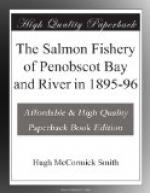Comparative data relative to the salmon fishery.
In 1880 the catch of salmon in Penobscot Bay and River and their tributaries was 10,016, having an estimated weight of 110,176 pounds. The weirs and traps used numbered 230; the gill nets, 36. The fishery yielded 169,894 pounds, valued at $32,800, in 1887; 192,177 pounds, worth $38,049, in 1888; 140,469 pounds, valued at $31,156, in 1889, and 92,282 pounds, worth $19,124, in 1892.
As previously shown, in 1895 193 traps and 10 gill nets took 4,395 salmon, weighing 65,011 pounds, valued at $11,356, and in 1896, 184 traps and 11 gill nets caught 6,403 salmon, weighing 80,175 pounds, valued at $12,716.
Comparing 1896 with 1880, it appears that there was a reduction of 27 per cent in the number of nets used and a decrease of 36 per cent in the number of salmon caught. A relatively large catch was made in 1887 to 1889, inclusive, and the decrease in 1896, as compared with those years, was marked. From 1892 to 1895 the output declined nearly 30 per cent, and the general tendency for the past eight years has been toward a decrease, 1896 presenting a very pleasing contrast, of which the fishermen all make mention.
Following is a continuous record from 1874 to 1896 of two of the most successful salmon weirs. These are located on the east side of the river, in the town of Penobscot, a short distance from the southern end of Whitmore Island. The number of salmon taken in 1896 was 20 per cent greater than in any previous year and over 93 per cent greater than the average for the preceding 22 years. Similar comparative statements for other nets are at hand, showing the increase in 1896 over previous seasons.
Table. Record of two Penobscot River salmon weirs, from 1874 to 1896, inclusive.




